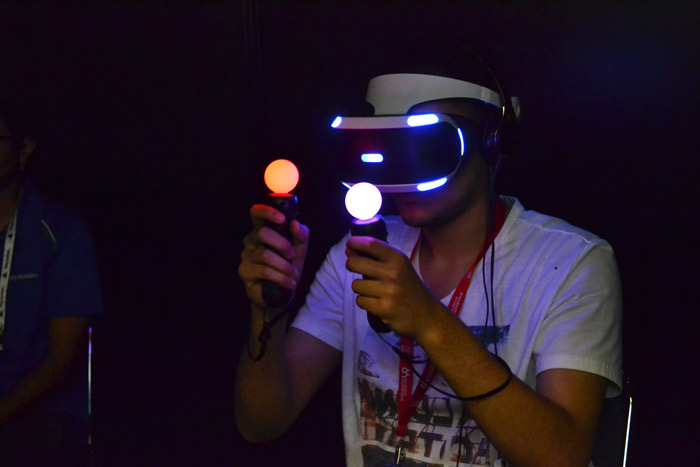Whether it’s Candy Crush Saga or Fallout 4, video games are an increasingly integral part of everyday life. The enormous range of developers churning out games means that there is more or less something for everyone on the market. The challenge remains, however, to get noticed and then get published. Today, one of the best places for video game creators to gain popularity is at the Montreal International Game Summit (MIGS). Since its inception in 2004, MIGS has provided a platform for video game creators and enthusiasts to collaborate as well as showcase the latest hot talents and emerging technologies.
Running from Nov. 15 to 17, MIGS 2015 began in earnest with the Big Indie Pitch event, a travelling showcase sponsored by the online magazine Pocket Gamer. During the competition, several independent developers demoed their mobile games before a panel of judges, Dragon’s Den-style. Everything from wingsuit-simulators to finger-based sorcerer combat games were showcased, and in the end, one of the simpler games took home the gold. The crowned victor, Grumz, requires only one finger to play; users must tap their screen to stop an infinitely yo-yoing ball from getting wrecked by other polygons.
Though seemingly simple, the use of elegant and straightforward interfaces continues to dominate the industry, as seen in the Expo Zone. Here, MIGS participants presented their technology and games to attendees. Local powerhouse Ubisoft presented its brutal new third-person hack ‘n slasher For Honor in a tense 4v4 tournament, while Quebec City-based unknown Parabole showed off a visually minimalist, yet striking, exploration through northern Quebec’s wilderness with Kôna.

Aside from the ongoing expo-zone, seminars and talks were presented throughout every day of the conference. One session featured Dominic Vega and Jason Kantor—resident aural wizards with developer Avalanche Studios—as they debriefed the entirety of their experience with the sound design and implementation in Avalanche’s nuclear-powered blockbuster: Just Cause 3. In their talk, Kantor and Vega highlighted the challenge of developing complex sound cascades that could be available at any second with the game’s plethora of weapons, vehicles, and destructible objects at the player’s disposal. It’s easy to tell the duo knows their stuff; coherent explanations made a concept as esoteric as spline––polynomial functions used to create everything from level-up schemes to in-game camera movement––feel as accessible as elementary school arithmetic.
“[Just Cause 3’s mix of] aircraft, motorboats, and land vehicle [sounds] were a delight to work on,” explained Kantor. “They all sound absolutely incredible.”
Dave Miner, product marketing manager with Yamaha, has been working with fellow music equipment company Steinberg to release the newest version of their acclaimed sound software Nuendo. The result is Nuendo 7—a software for editing and mixing sound, complete with a special tie-in for game developers. The tie-in is full integration with game audio group Audiokinetic’s ubiquitous sound software Wwise, allowing for simple drag-and-drop operation when exporting mixed sounds from Nuendo 7 to Wwise. Because of this, it now takes mere seconds, instead of hours, to transfer sounds between the two systems—which is used to put the desired sound into a game. Remarkably, this system has compatibility with platforms ranging from Android to Xbox One, and every game engine from Unity to CryEngine. In a serendipitous discovery, Miner and his team found that the Nuage mixing console’s touch feedback and ergonomic design even enable editing via virtual reality (VR) headset, effectively immersing the user in both the game and Nuendo 7 interface.
“[When we released the technology] we had no idea [this capability] even existed,” Miner said.

This interest in VR was seen in works being produced by many other MIGS participants. For example, the Digital Imagery Research and Development Centre (CDRIN), is based out of CÉGEP de Matane, and possesses Canada’s largest motion capture studio—a taste of which was presented at MIGS.
A welded metal framework surrounded by rigging fitted with infrared lights and cameras provide the staging for the experience. Clad in a bodysuit covered in reflective spheres, Camille Tremblay, CDRIN’s project manager, has her every movement rendered onscreen in real-time by cameras catching the infrared light reflected back from the spheres. Attendees are invited to join by putting on a CDRIN VR headset. While wearing the headset, users ‘see’ Tremblay as a spaceship captain inside a futuristic elevator, which is used to visit three floors featuring different virtual environments. The most notable scene is a balcony overlooking a breath-taking mountainside castle. But the VR headset goes beyond what users see, it can change the very laws of physics. In this VR world, Tremblay steps off the castle balcony and walks on air. Participants, if they dare, are encouraged to follow.
While developers cannot yet nullify Earth’s gravity, other technologies are being introduced to create unique gaming experiences. North Carolina-based Spark Plug Games was founded by John O’Neill, responsible for the rapid-fire, run ‘n gun Mech Runner. But O’Neill’s game has a twist—it uses eye-tracking software, courtesy of Tobii Technology, in addition to a hand-held controller. With this, gamers can simply look at enemies in order to target them for destruction. If combined with a VR headset, Tobii’s EyeX Tracker could allow users the unprecedented experience of a world that reacts dynamically to both sight and bodily orientation in real-time.
With the rapidly expanding set of tools available to game developers, new gaming mechanics are being used to tell uniquely immersive stories. After all, the most memorable games allow a person to become wholly invested––mentally and emotionally––in the experience. While big name developers may be slow to challenge conventional storytelling, this is, fortunately, where indie developers really shine. Games like the eerie, black and white side-scrolling puzzle game Limbo––a stunning example of games as an art form––can be made without massive budgets and VR technology. Add in the crowdfunding and communicative capacity of the internet, and indie developers can churn out innovative cult classics indefinitely.








